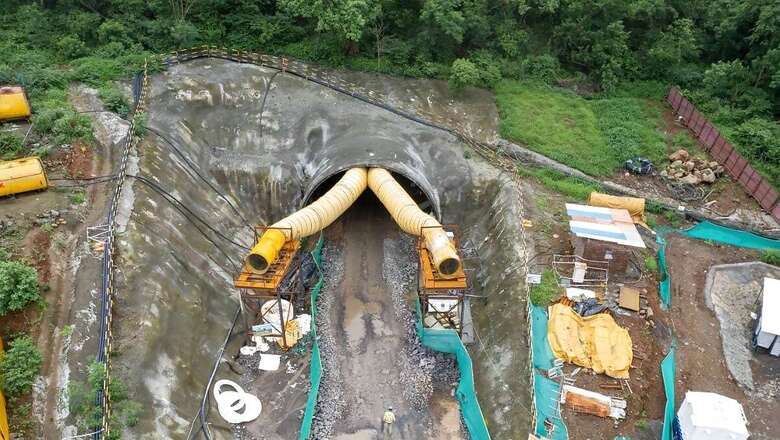
views
The construction of India’s first undersea bullet train tunnel, a part of the ambitious Mumbai-Ahmedabad High-Speed Rail (HSR) Corridor, has achieved significant milestones in Maharashtra.
The 21-kilometre-long tunnel, which will stretch from the Mumbai underground station at Bandra-Kurla Complex (BKC) to Shilphata, is a critical segment of this landmark project. Among its many noteworthy features is a seven-kilometre undersea section beneath Thane Creek. This will be India’s first venture into undersea tunnelling for a high-speed rail project, symbolising a leap forward in the nation’s infrastructure development.
The construction of the 21-kilometre tunnel is divided into two phases. The first part, covering 16 kilometres, is being excavated using Tunnel Boring Machines (TBMs). These machines are specifically designed for precision excavation, minimising the environmental impact while ensuring safety and efficiency. The second phase involves the construction of a five-kilometre section using the New Austrian Tunnelling Method (NATM), which is often used for complex underground projects.

The NATM relies on the surrounding ground to provide the tunnel support during excavation, which is considered an advanced and adaptive approach. The section beneath Thane Creek is one of the most significant aspects of the project as it marks India’s debut in undersea tunnelling for a high-speed rail system.
Progress on various construction fronts along the Mumbai-Thane route has been impressive. At the Mumbai High-Speed Rail (HSR) station site in Bandra-Kurla Complex, a shaft measuring 36 meters in depth has seen considerable advancement. Secant piling, an important process for stabilising underground excavation areas, has been fully completed at this site, and the excavation work is now in full swing. The depth and scale of this shaft demonstrate the complexity and precision required to ensure the structural integrity of the tunnel.
Similarly, in Vikhroli, another key shaft site has seen remarkable progress. This shaft, which plunges 56 meters below ground, has also achieved 100 per cent completion of secant piling. Excavation work at Vikhroli is advancing rapidly, with 92 per cent of the task completed to date. The near-completion of this shaft marks a major milestone in the tunnelling process as it clears the way for future phases of construction. This is one of the deepest shafts on the route, reflecting the technical challenges and the innovative solutions being applied to overcome them.
Further north along the route, at Sawli, near Ghansoli, the excavation work for a 39-meter-deep shaft has been fully completed. Sawli is set to become a key site for tunnel boring, with the first Tunnel Boring Machine (TBM) expected to descend into the earth by the end of this year. This marks a critical moment for the project as TBMs are integral to completing the extensive tunnelling required for the bullet train to traverse underground.
Meanwhile, the Shilphata site, where NATM will be used, has also seen considerable progress. The NATM portal, the access point for the five-kilometre section of the tunnel, has been fully constructed, and 200 meters of excavation work have been completed. The use of NATM here will allow engineers to work with complex geological conditions in the area, ensuring that the tunnel is both safe and stable.
Another significant achievement is the completion of the Additional Driven Intermediate Tunnel (ADIT) Portal, a 394-meter tunnel that was finished in a record time of six months. The ADIT portal is designed to provide two additional excavation faces, which will allow workers to speed up the tunnelling process by working on multiple fronts simultaneously. The completion of this portal will facilitate faster progress, accelerating the completion of more than 700 meters of underground tunnel work.
To ensure the safety and structural stability of surrounding areas, geotechnical instruments such as inclinometers, vibration monitors, ground settlement markers, and tilt meters have been installed across the construction sites. These instruments play a crucial role in monitoring potential slope movements, ground settlement, vibrations, and cracks. This ensures that the ongoing underground work does not affect nearby structures and maintains the safety of the surrounding environment.
The undersea tunnel beneath Thane Creek is not just a technological marvel; it is a pivotal part of the larger Mumbai-Ahmedabad HSR Corridor, which promises to revolutionise travel between the two cities. Once completed, the bullet train will drastically cut down travel times and mark a new chapter in India’s transportation infrastructure. This project, incorporating cutting-edge engineering techniques and advanced safety measures, positions India as a global leader in high-speed rail technology.
















Comments
0 comment